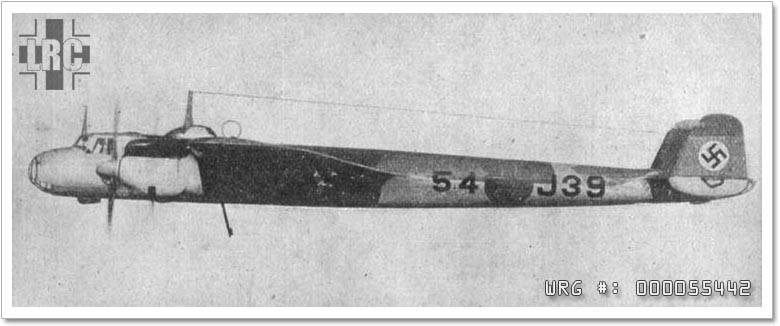Early Daimler-Benz-powered variants
The initial production variants were the Do 17E-1 bomber, which was tested with two Daimler-Benz DB 600, and
Do 17F-1 reconnaissance aircraft, powered like the early prototypes with BMW VI engines, which entered
production in late 1936. The first Luftwaffe units converted to the Do 17 in early 1937.
 Dornier Do 17E-1 of 9./KG 255
Dornier Do 17E-1 of 9./KG 255
The Do 17E-1 was equipped with two BMW VI 7.3D inline engines of 750 PS each. The crew numbered three. The
radio operator manned the two 7.92 mm MG 15 machine guns within a B-Stand pod in the rear cockpit. They had
750 rounds of ammunition. The bomb bay was divided into two compartments. Each had five bomb racks with
individual capacity of 50 kg (110 lb). A single ETC 500/IX bomb rack could be mounted externally underneath
the aircraft to carry a 500 kg bomb. A Do 17 E-1 with the designation D-AJUN was tested with an unusual
configuration, two SC 500 bombs mounted side by side under the fuselage. It showed a notable performance
reduction due to the increase in weight and drag, this configuration was not used operationally. The E-1
continued to carry low bomb loads into the Second World War. The performance of the E-1 enabled it to reach
a speed of 330 km/h (210 mph) at 3,000 m (9,800 ft). Conducting a shallow dive the light frame of the Do 17
could reach 500 km/h (310 mph). Its maximum ceiling was 5,500 m (18,000 ft).
Several E-1s were rebuilt as E-2 or E-3, at least three E-2 and one E-3 were used by DVL and Hansa-Luftbild
GmbH (Hansa Aerial Photography Ltd) in a secret military reconnaissance role prior to the war.
The Do 17F-1 was a long-range reconnaissance aircraft based on field modified Do 17Es. The Do 17 prototype V8
was used to test the configuration of the F-1 and V11 for the F-2. The defensive armament consisted of a
MG 15 in the B- and C-Stand (B-Stand - an upper rear firing position, C-Stand — lower gun emplacement). The
fuselage had two cameras along with six ejector tubes for flashlight cartridges. The F-1 would see service
until replaced by the Do 17 P in 1938. Only one F-2 was ever built, it was designated D-ACZJ and was used
by Zeiss-Jena Company as a factory aircraft.
Conversion of two E-2 series aircraft with two BMW 132F radial engines led to the Do 17 J-1 and J-2. These
aircraft served as flight testing machines to evaluate the BMW 132 for usage in the Do 17. The aircraft were
the V18 (Wrk Nr, or Werknummer meaning works/factory number, 2021) and V19 (Wrk Nr 2022) prototypes. Trials
began in late 1937. A similar conversion, but with Bramo 323 radial engines, led to the designation Do 17
L-1 and L-2. Two Do 17 (Wrk Nr 2031 and 2032) were renamed as V20 and V21 prototypes and used to evaluate
the Bramo 323 for usage in the Do 17. The test were satisfactory and all future production models would be
equipped with this engine.
After seeing the Do 17M V1 at the Zürich air races in 1937, the Yugoslav Royal Air Force bought license rights
for production at the Drzavna Fabrika Aviona factory in 1938. They equipped it with the more powerful
Gnome-Rhône 14N radial engine (although the French exaggerated its performance). Dornier designs were
delivered to the Pomorsko Vazduhoplovstvo (Naval Aviation - PV) in 1926, namely the Dornier Komet and Dornier
Do Y heavy bombers. The Yugoslavs were familiar with Dornier designs, and on 19 November 1935 Yugoslav
pilots test-flew the Do 17 V-3 prototype, D-ABIH, W.Nr. 258. They decided to select the Do 17 for service,
despite it being more expensive than any other aircraft, because of the German willingness to deliver them
quickly without limitations on numbers.
The Do 17L-0 and Do 17M-0 were developed in parallel as replacements for the earlier E and Fs, the L being the
reconnaissance version. Both were designed around the more powerful DB 600A engines, delivering about 746 kW
(1,000 hp). Two L and one M versions were built as prototypes, both with another MG 15 in the nose. The
first prototype of the revised version, the Do 17M V1 (D-ABVD) was powered by two DB 600s, and demonstrated
impressive performance, including a maximum speed of 425 km/h (264 mph).
At the International Military Aircraft Competition at Zürich, Switzerland in 1937, the Dornier Do 17M V1
proved a leader in its class and was faster than the fastest foreign fighter, the French Dewoitine D.510.
The Do 17, along with the Messerschmitt Bf 109, won many prizes, demonstrating the prowess of German aviation
design.
Sources:
Gunston, Bill -
The Encyclodepia of the Worlds Combat aircraft, 1976,
Chartwell Books, Inc., New York
Brown, Eric, Captain -
Wings of the Luftwaffe
, 1979, Airlife Publishing Ltd., Shrewsbury
Gunston, Bill & Wood, Tony -
Hitler's Luftwaffe
, 1977, Salamander
Books Ltd., London
Donald, David -
The Complete Encyclopedia Of World Aircraft, 1997, Brown Packaging Books Ltd., London
Wikipedia - Dornier Do 17

 , 1979, Airlife Publishing Ltd., Shrewsbury
, 1979, Airlife Publishing Ltd., Shrewsbury , 1977, Salamander
Books Ltd., London
, 1977, Salamander
Books Ltd., London





